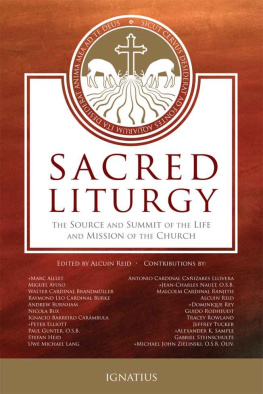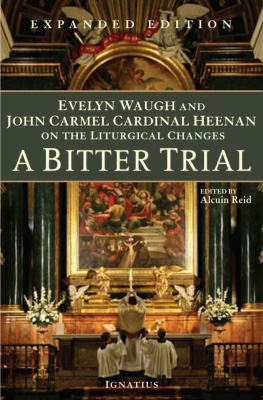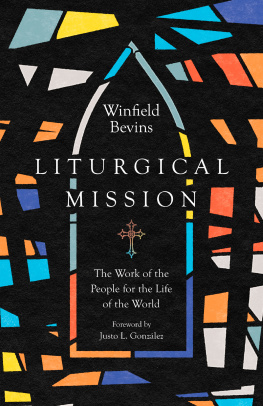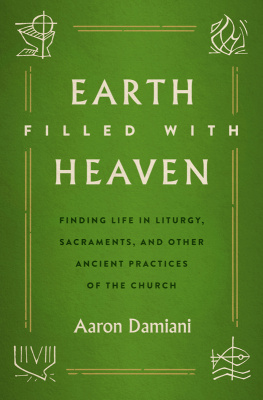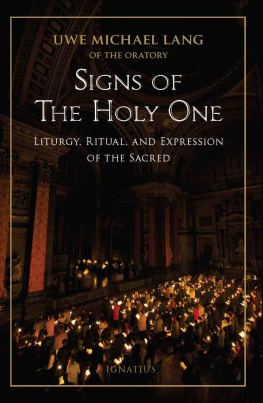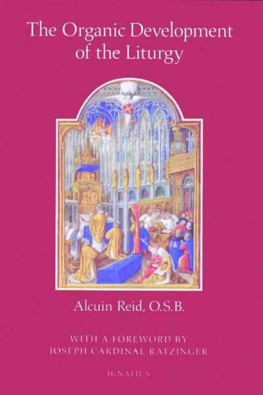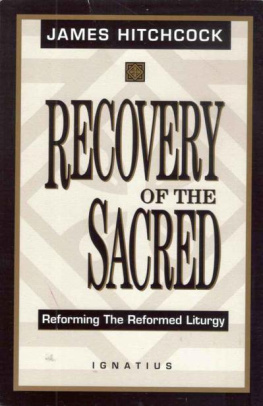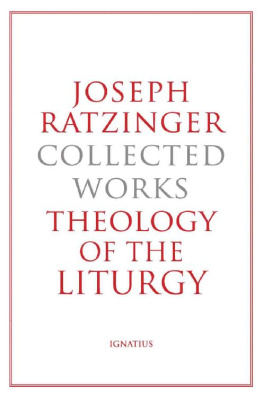THE SACRED LITURGY
THE SACRED LITURGY
Source and Summit of the
Life and Mission of the Church

The Proceedings of the International
Conference on the Sacred Liturgy
Sacra Liturgia 2013
Pontifical University of the Holy Cross, Rome
2528 June 2013
EDITED BY ALCUIN REID
IGNATIUS PRESS SAN FRANCISCO
Unless otherwise noted, Scripture quotations (except those within citations) have been taken from the Revised Standard Version of the Holy Bible, Second Catholic Edition, 2006. The Revised Standard Version of the Holy Bible: the Old Testament, 1952, 2006; the Apocrypha, 1957, 2006; the New Testament, 1946, 2006; the Catholic Edition of the Old Testament, incorporating the Apocrypha, 1966, 2006; the Catholic Edition of the New Testament, 1965, 2006 by the Division of Christian Education of the National Council of the Churches of Christ in the United States of America. All rights reserved.
Cover design by Milo Persic
2014 by Ignatius Press, San Francisco
ISBN 978-1-58617-786-7 (PB)
ISBN 978-1-68149-412-8 (E)
Library of Congress Control Number 2013917064
Printed in the United States of America
Contents
Editors Preface
On 4 December 1963, closing the second session of the Second Vatican Council, Ven. Paul VI spoke of the first fruit of the Council, its Constitution on the Sacred Liturgy, Sacrosanctum Concilium , which he had just promulgated:
Indeed, our first duty is the worship of Almighty God. Before we act as Christians we must in fact be Christiansand it is Christ Himself at work in the Sacred Liturgy of His Church who makes us His children, who nourishes, forms, establishes and heals us in our Christian life and vocation.
The reality of the primacy of the Sacred Liturgy for Christian life led the Fathers of the Second Vatican Council to call for profound liturgical formation in order to bring about participatio actuosa a conscious and life-giving connection with and immersion in the riches of the liturgical life of the Church by all of Christs faithful. Such living participation was seen as the essential foundation for Christian life and mission in the modern world.
So too it was judged that ritual reforms would help achieve participatio actuosa . This is the raison dtre the whyof Sacrosanctum Concilium .
The Constitutions theology, read with a hermeneutic of reform in continuity and in a true spirit of ressourcement , rightly takes its place amidst the currents of theological renewal of the twentieth century. It is the theology taught by an Ecumenical Council and whilst it is not de fide definita , one would be foolish to reject it out of hand. The Constitutions fundamental principlesof seeking a true participatio actuosa in the Churchs liturgical life for all the faithful by means of carrying out widespread and profound formation in the Sacred Liturgy (cf. n. 14)which are in fact those of St. Pius X, Ven. Pius XII and of the twentieth-century liturgical movement, with roots deep in the previous centuriesare of perennial value. The general principles which flow from these (cf. nn. 2232), also reflect sound liturgical tradition. Its subsidiary principles (cf. nn. 3346) are just that: subordinate to the greater realities preceding them and may be evaluated accordingly. The policies of the Constitution, which are found in its subsidiary principles and in the remainder of Sacrosanctum Concilium are and always were contingent. That the Council Fathers adopted them indicates their value in their judgment, and in the authoritative judgment of Paul VI through his promulgation of the Constitution.
Historically it is now clear that some of the liturgical reforms enacted in the name of the Council went beyond the carefully nuanced provisions of the Council itself as set forth in Sacrosanctum Concilium . It is also clear fifty years later that the widespread renewal of liturgical and indeed of Christian life for which the Fathers of the Council hoped has not been achieved: the proportion of Catholics participating regularly in the Sacred Liturgy or otherwise practicing their faith is substantially less now than it was then. Whilst this decline has many causes, the reformed liturgy as it has been implemented has not been a significant factor in arresting it.
We must have the courage, then, to admit that some of these policies, either in their conception or in their (mis-)application, have not necessarily served the Constitutions fundamental aims well. It may be that some policies, whilst judged apposite fifty years ago, in the light of radically changed circumstances in the Church and world of the twenty-first century, can be seen today to be no longer as vital as they were thought to be in 1963. It may be that the intentions behind some policies were distorted in their implementation and in fact have brought about unhelpful results. It may also be that, with the advance of scholarship, the difference, if not the distance, between Sacrosanctum Concilium and the liturgical tradition it sought moderately to reform, and the rites produced by the Consilium charged with implementing the Constitution, has become more apparent.
Yet the Councils insistence that the Sacred Liturgy is the summit toward which the activity of the Church is directed [and] at the same time it is the font from which all her power flows ( Sacrosanctum Concilium , 10), remains true. In our world which so needs to hear and to live the Gospel, what are we to do if our access to the source and summit of our Christian life is not what it should be, indeed not what the Second Vatican Council intended?
The answer is that we must look again in all humility at the question of the liturgy, not with the blinkered eyes of partisans of the liturgy wars that have marked recent decades, but with the vision of the fathers of the Council, who could see clearly the necessity of maintaining sound tradition whilst being open to legitimate development (cf. Sacrosanctum Concilium , 23). We must be prepared to make a liturgical examination of conscience, and where necessary to make amends.
In doing this we must safeguard the gains in liturgical practice since the Council. Thankfully the expectation of participating in the liturgical rites is now widespread. So too, it is beneficial that the reformed rites include a wider selection of readings from Sacred Scripture and that their reading in the vernacular has facilitated their comprehension (cf. Sacrosanctum Concilium , 35 1; 36 2). And the renewed use of many ancient liturgical texts, especially prefaces, is a valuable development.
Benedict XVI set the challenge of mutual enrichment between the two (cf. Letter, 7 July 2007), a challenge which remains. So too, he underlined the legitimate diversity possible in Western Catholic liturgy (cf. Sacrosanctum Concilium , 38), insisting that one such example is nothing less than a treasure to be shared (cf. Anglicanorum Ctibus , 4 November 2009, 3).
Any reappraisal of Sacrosanctum Concilium s policies, of their implementation and of subsequent liturgical practice will raise the question of a reform of the reform. This question must be taken seriouslyout of fidelity to the Council, out of fidelity to the liturgical tradition the Council received and indeed in the light of the urgent pastoral needs of our day.
Sacra Liturgia 2013 took place during the Year of Faith (20122013), which Benedict XVI called to mark the fiftieth anniversary of the Second Vatican Council and in order to provide renewed impetus in the service of belief and evangelization ( Porta Fidei , 12). Far from being motivated by an ostentatious preoccupation with the liturgy (cf. Pope Francis, Evangelii Gaudium , 95), Sacra Liturgia 2013 was concerned from the outset to consider the liturgy, liturgical formation and celebration as the point of departure for the New Evangelisation (Bishop Dominique Rey, Conference Announcement, 2 October 2012).
Next page
